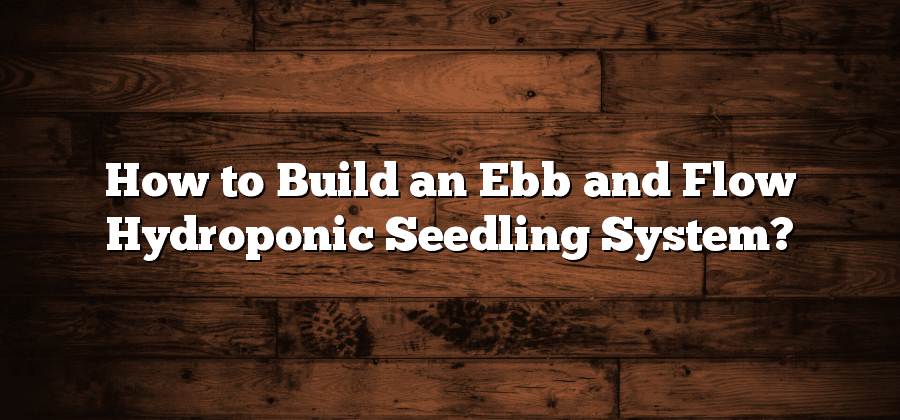Understanding the Basics of Hydroponics
Hydroponics is a modern method of cultivating plants without the use of soil. Instead, it relies on a nutrient-rich water solution to nourish the plants. This innovative approach offers numerous advantages, especially in regions where traditional farming methods are not feasible due to limited land or soil quality.
One of the key benefits of hydroponics is that it allows for precise control over the growing conditions. Every aspect, from the amount of nutrients to the pH levels, can be adjusted to ensure optimal plant growth. Additionally, hydroponic systems require less water compared to traditional soil-based farming, making them more sustainable and environmentally friendly. This method also minimizes the risk of pests and diseases, as plants are grown in a controlled environment, reducing the need for harmful pesticides. With the basic understanding of hydroponics, let’s delve into the process of setting up an efficient ebb and flow system, which plays a crucial role in the success of your hydroponic garden.
Choosing the Right Materials for Your Ebb and Flow System
When it comes to setting up an efficient ebb and flow hydroponic system, choosing the right materials is crucial. The materials you select should be durable, water-resistant, and capable of withstanding the constant ebb and flow cycles. One of the most common materials used for ebb and flow systems is PVC piping. PVC pipes are affordable, readily available, and easy to work with, making them a popular choice among hydroponic growers. Another essential material for your ebb and flow system is the flood tray. This tray will hold your plants and allow the nutrient solution to flood and drain. It is essential to choose a flood tray that is sturdy, waterproof, and the appropriate size for your specific needs. Additionally, you will need fittings, tubing, and a submersible pump to complete your ebb and flow system. These components must be made from high-quality materials that can withstand constant exposure to water. By selecting the right materials for your ebb and flow system, you will ensure its longevity and efficiency.
Setting Up the Reservoir and Submersible Pump
To ensure the success of your hydroponic system, it is vital to carefully set up the reservoir and install a reliable submersible pump. The reservoir serves as the main water source for your plants, providing the necessary nutrients and oxygen. When choosing a reservoir, opt for a sturdy and food-safe material, such as plastic or stainless steel, that can hold an adequate volume of water for your specific needs. Additionally, consider the size and location of the reservoir, ensuring it can accommodate the required amount of solution and fits well within your space constraints.
Once you have selected the reservoir, it is time to install the submersible pump. This component plays a crucial role in the circulation of the nutrient solution throughout your system. When positioning it in the reservoir, make sure the pump is fully submerged to avoid any potential overheating issues. Also, check that the pump’s electrical cord is securely connected to a GFCI (Ground Fault Circuit Interrupter) outlet, providing a safe power supply for the pump’s operation. Remember to regularly inspect and clean the pump to maintain its efficiency and prevent any clogging that could hinder the overall system performance.
Designing the Growing Tray and Drainage System
To successfully design the growing tray for your hydroponic system, it is crucial to consider several factors. Firstly, ensure that the tray is large enough to accommodate your chosen plants, allowing sufficient space for their roots to spread and grow. A general guideline is to allocate approximately one square inch of tray space per plant. Additionally, it is important to select a material for the tray that is durable, weather-resistant, and non-toxic. Common options include plastic or food-grade PVC, which can easily be customized to fit the dimensions of your system.
Equally important is designing an efficient drainage system for your hydroponic setup. Proper drainage is essential to prevent oversaturation and root rot, ensuring the health and vitality of your plants. One option is to include small holes or slits in the bottom of the tray to allow excess water to escape. Alternatively, you can incorporate a slope in the design, allowing water to naturally flow towards a designated drain or collection area. Whichever method you choose, regularly monitoring and adjusting the drainage system is crucial to maintain optimal growing conditions for your plants.
Selecting the Ideal Growing Medium for Seedlings
There are several options available when it comes to selecting the ideal growing medium for seedlings in a hydroponic system. It is important to choose a medium that provides adequate support and nutrition for the young plants. One popular choice is rockwool, which is made from spinning molten rock into fibers. Rockwool is lightweight, retains moisture well, and offers good drainage. Another option is coco coir, which is derived from coconut husks. Coco coir is a sustainable and renewable medium that has excellent water retention and aeration properties. It is also pH neutral and naturally resistant to diseases and pests. Peat moss is another common choice, although it is less sustainable and requires careful monitoring of pH levels. Ultimately, the ideal growing medium for seedlings will depend on factors such as the specific crop being grown, the desired nutrient requirements, and personal preferences.
When selecting a growing medium for seedlings, it is crucial to consider the compatibility with the hydroponic system being used. Some mediums work better with certain systems, such as drip or flood and drain, while others are more versatile. Additionally, it is important to ensure that the medium has the appropriate level of moisture retention and drainage to prevent water-logging and root rot. It may also be beneficial to choose a medium that is sterile or treated to minimize the risk of diseases and pests. Overall, the ideal growing medium for seedlings should provide a stable and supportive environment for healthy root development, enabling the young plants to thrive and grow vigorously.






